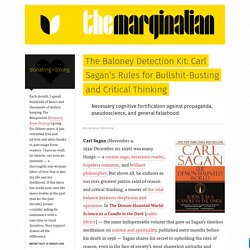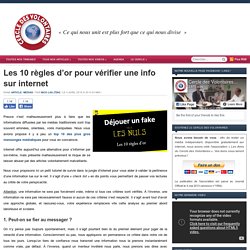

Comment repérer les fausses nouvelles? How artificial intelligence can detect – and create – fake news. When Mark Zuckerberg told Congress Facebook would use artificial intelligence to detect fake news posted on the social media site, he wasn’t particularly specific about what that meant.

Given my own work using image and video analytics, I suggest the company should be careful. Despite some basic potential flaws, AI can be a useful tool for spotting online propaganda – but it can also be startlingly good at creating misleading material. Researchers already know that online fake news spreads much more quickly and more widely than real news. My research has similarly found that online posts with fake medical information get more views, comments and likes than those with accurate medical content. In an online world where viewers have limited attention and are saturated with content choices, it often appears as though fake information is more appealing or engaging to viewers.
Detecting falsehood An endless cycle Context is also key. I trained fake news detection AI with >95% accuracy, and almost went crazy. The Single Best Tool for Detecting Fake News - Civics Nation. Apply the CRAAP Test to every news story you see.

Photo: Shutterstock Heard the phrase “fake news” lately? We thought so. Us, too. And… it’s getting old. The Baloney Detection Kit: Carl Sagan’s Rules for Bullshit-Busting and Critical Thinking. Carl Sagan (November 9, 1934–December 20, 1996) was many things — a cosmic sage, voracious reader, hopeless romantic, and brilliant philosopher.

But above all, he endures as our era’s greatest patron saint of reason and critical thinking, a master of the vital balance between skepticism and openness. In The Demon-Haunted World: Science as a Candle in the Dark (public library) — the same indispensable volume that gave us Sagan’s timeless meditation on science and spirituality, published mere months before his death in 1996 — Sagan shares his secret to upholding the rites of reason, even in the face of society’s most shameless untruths and outrageous propaganda. Through their training, scientists are equipped with what Sagan calls a “baloney detection kit” — a set of cognitive tools and techniques that fortify the mind against penetration by falsehoods: The kit is brought out as a matter of course whenever new ideas are offered for consideration.
Frequently Asked Questions. Who works at Snopes?

Snopes has been investigating folklore, urban legends, hoaxes, memes, and rumors on the internet for more than 25 years. It began as something of a hobby and has grown considerably since. Now our team of researchers, writers, developers, and support staff is probably greater than you can fit in a large passenger van, although we haven’t scientifically tested that yet. What does ‘snopes’ mean? Snopes is the name of a family of characters who appear throughout the works of American writer William Faulkner. When David Mikkelson, creator of snopes.com, began publishing on the internet in the late 1980s, he worried even back in those relatively uncrowded days that no one would remember yet another David.
Wondering about the pronunciation? Is Snopes partisan? What makes Snopes a reliable resource? Of course, we don’t expect anyone to accept us as the ultimate authority on any topic. HoaxBuster - Vérifier l'information en circulation sur le web. Décodex: vérification de sources d'informations, pages Facebook et chaînes YouTube. Hoaxkiller.fr, moteur de recherche anti-hoax. Les 10 règles d'or pour vérifier une info sur internet. Preuve n’est malheureusement plus à faire que les informations diffusées par les médias traditionnels sont trop souvent erronées, orientées, voire manipulées.

Nous vous avions proposé il y a peu un top 10 des plus gros mensonges médiatiques pour vous en convaincre. Internet offre aujourd’hui une alternative pour s’informer par soi-même, mais présente malheureusement le risque de se laisser abuser par des articles volontairement malveillants. Nous vous proposons ici un petit tutoriel de survie dans la jungle d’internet pour vous aider à valider la pertinence d’une information lue sur le net. Il s’agit d’une « check list » en dix points vous permettant de passer vos lectures au crible de votre perspicacité. Attention, une information ne sera pas forcément vraie, même si tous ces critères sont vérifiés. 1. On n’y pense pas toujours spontanément, mais il s’agit pourtant bien là du premier élément pour juger de la véracité d’une information. 2. 3. 4. Un article non daté est toujours suspect. Ask FactCheck Archives. 6 outils pour vérifier les images qui circulent lors des crises.
Article mis à jour le 18 novembre 2015 par Fidel Navamuel Pas facile de faire la part des choses quand l’actualité s’emballe et que les chaines d’info en continu mais surtout les réseaux sociaux démultiplient à l’infini la diffusion des informations et des images. Une image puissante est à elle seule une histoire qui peut se propager à une vitesse phénoménale.